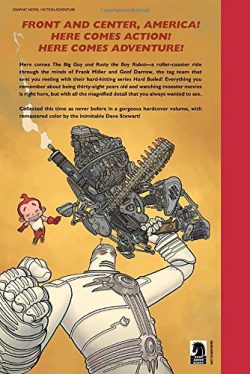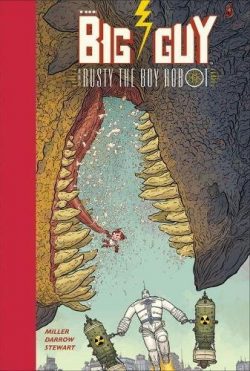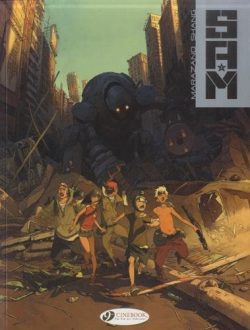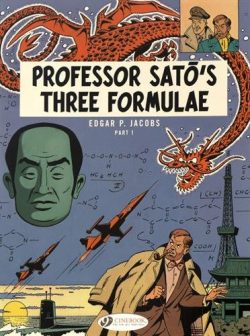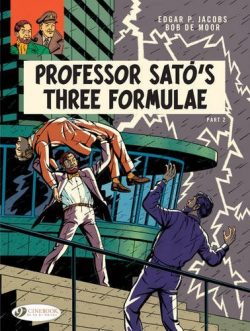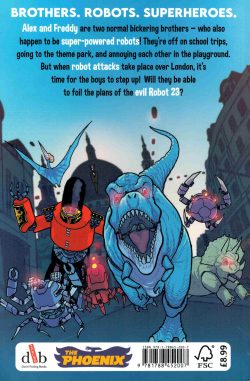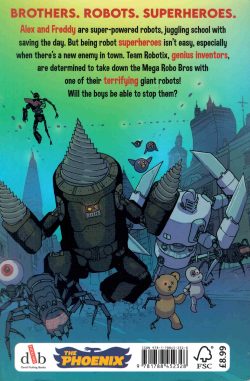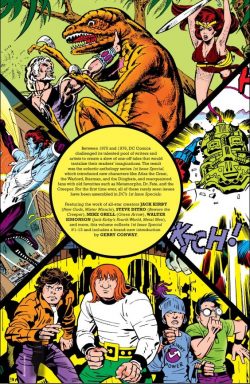

By Jack Kirby, Joe Simon & Jerry Grandenetti, Bob Haney & Ramona Fradon, Robert Kanigher & John Rosenberger, Michael Fleischer & Steve Ditko, Mike Grell, Martin Pasko & Walter Simonson, Gerry Conway & Frank Redondo, Mike Vosburg, Denny O’Neil & various (DC Comics)
ISBN: 978-1779501776 (HB)
Nobody knows where ideas come from, but at least in comics it’s easy to see how they turn out. Mainstream companies have always favoured try-out vehicles – like Gold Key’s Four Color; Magazine Enterprises’ A-1; DC’s Showcase and The Brave and the Bold; Charlton Bullseye; Marvel Premiere and Marvel Spotlight – and the principle was a sound one, graphically depicted in every first issue. In the late 1950s, editors at National/DC were apparently bombarded with readers’ suggestions for new titles and concepts and the only possible way to feasibly prove which would be popular was to offer test runs and assess the fans reactions. The results kickstarted the Silver Age and introduced dozens of immortal, profitable characters and concepts…
When the comic book revolution seemed to be fading out in the mid-1970s it was revived in part by innovative scheduling and a new awareness of the need to experiment, leading to this sturdy hardback/digital compilation of some genuine hits and near-misses…
Originally printed as 1st Issue Special #1-13, spanning April 1975 to April 1976, it’s supplemented by then-Editor Gerry Conway’s revelatory Introduction ‘If at First You Don’t Succeed’.
Famed for his larger-than-life characters and gigantic, cosmic imaginings, Jack Kirby was an astute, imaginative, spiritual man who had lived through poverty and gangsterism, the Depression, Post-War optimism, Cold War paranoia, political cynicism and the birth and death of peace-seeking counter-cultures. He was open-minded and utterly wedded to the making of comics stories on every imaginable subject. He always believed sequential narrative was worthy of being published as real books beside mankind’s other literary art forms. It’s a genuine shame he didn’t live long enough to see today’s vibrant and vastly varied graphic novel industry.
On ending his third sojourn at the company – just prior to returning to Marvel for 2001: A Space Odyssey/Machine Man, Captain America, Black Panther and more – Kirby unleashed a bunch of new options for DC to expand and capitalise on over the coming decades. Other than Kobra – which was hastily reworked by other hands and given its own series – they all appeared in the new Comics Showcase.
Debuting in the debut 1st Issue Special #1 and inked by D. Bruce Berry, ‘Atlas the Great!’ harks back to the dawn of human civilisation and the blockbusting travails of mankind’s first super-powered champion in a bombastic and tantalizing Sword & Sorcery yarn.
Kirby’s collaborations with fellow industry pioneer Joe Simon always produced dynamite concepts, unforgettable characters, astounding stories and huge sales, no matter what genre avenues they pursued. They blazed trails for so many others to follow; reshaping the nature of American comics with their innovations and sheer quality. Simon & Kirby offered stories shaped by their own sensibilities: always testing fresh ideas and avenues. They chased ideas for comics nobody else ever had before, identifying gaps and probing potential.
Although junior plutocrat Richie Rich had been coining it for Harvey Comics for decades, Simon and old collaborator Jerry Grandenetti looked for drama as well as laughs in the set-up and came up with ‘The Green Team: Boy Millionaires’ for the second 1st Issue.
Here magnate minors The Commodore (shipping), JP Houston (oil) and Cecil Sunbeam (moviemaker) are joined by black shoeshine boy Abdul Smith after a banking error turns the industrious lad into an instant parvenu. Dedicated to adventure and social advancement, the kids then unwisely back ‘The Great American Pleasure Machine’…
The first of a string of potential revivals follows as Metamorpho the Element Man returns courtesy of fabled originators Bob Haney & Ramona Fradon. ‘The Freak and the Billion-Dollar Phantom’ sees Rex Mason seeking to thwart the vengeful schemes of a ghost betrayed by America’s Founding Fathers and resolved to destroy Washington DC.
For #4, Robert Kanigher, John Rosenberger & Vince Colletta introduce a truly novel but now unfortunately dated concept in ‘Lady Cop’.
Earnest, well-meaning and immaculately rendered by the criminally-underappreciated Rosenberger, the tale of college student Liza Warner – who survives a serial killer and takes control of her life by becoming a police officer – is rather heavy-handed, but addresses in ‘Poisoned Love’ issues of controlling boyfriends, parental abuse, underage sex and venereal disease with a degree of mature understanding we’d be hard-pressed to see these days. I think she was one of the few characters still dormant since her debut…
Kirby – with Berry – returned in #5 (August 1975) to revise his own Golden Age stalwart safari guide Paul Kirk replaced by a frustrated lawyer. This passing of a torch sees a devout evil-crusher working for an ancient justice-cult retire: beguiling his nephew – Public Defender Mark Shaw – to become the latest super-powered ‘Manhunter’ battling ancient wickedness with alien super-tech…
A rare but welcome digression into comedy manifested as ‘The Dingbats of Danger Street’ disgraced 1st Issue Special #6, with Mike Royer inking a bizarre and hilarious revival of Kirby’s Kid Gang genre starring four multi-racial street urchins united for survival and annoying the heck out of cheesy thugs and surreal super threats like Jumping Jack and The Gasser…
Steve Ditko’s startling psychedelic avenger The Creeper debuted in early 1968, parlaying his premier in Showcase #73 into a superb but brief run in Beware the Creeper before being cancelled with the sixth issue (March/April 1969) – by which time Ditko had all but abandoned his creation. It was fun and thrilling and – unlike many series which folded at that troubled time – even provided an actual conclusion, but somehow wasn’t satisfactory or what the public wanted.
This was a time when superheroes went into steep decline, with supernatural and genre material regaining prominence throughout the industry. With Fights ‘n’ Tights comics folding all over, Ditko concentrated again on Charlton’s mystery line, the occasional horror piece for Warren and his own projects…
In the years his own comic was dormant, the Creeper enjoyed numerous guest shots in other comics, which established that the city he prowled was in fact Gotham. When Ditko returned to DC in the mid-1970s, 1st Issue Special snapped him up.
Issue #7 (October 1975) gave the quirky crusader another shot at stardom in ‘Menace of the Human Firefly’ written by Michael Fleisher and inked by Mike Royer. It saw reinstated TV journalist Jack Ryder inspecting the fantastic felons in Gotham Penitentiary just as manic lifer Garfield Lynns breaks jail to resume his interrupted costumed career as the master of lighting effects.
By the time the rogue’s brief but brilliant rampage is over, the Creeper has discovered something extremely disturbing about his own ever-evolving abilities…
The story wasn’t enough to immediately restart the rollercoaster, but a few years later DC instituted a policy of giant-sized anthologies and the extra page counts allowed a number of lesser lights to secure back-up slots and shine again. Written and drawn by Ditko, The Creeper became a regular in World’s Finest Comics…
During the troubled 1970s the American comics industry suffered one of the worst of its periodic downturns and publishers desperately cast about for anything to bolster the flagging sales of superhero comics.
By revising their self-imposed industry code of practice (administered by the Comics Code Authority) to allow supernatural and horror comics, publishers tapped into the global revival of interest in spiritualism and the supernatural, and as a by-product opened their doors to Sword-and-Sorcery as a viable genre with Roy Thomas & Barry Windsor-Smith’s take on R. E. Howard’s Conan the Barbarian an early exemplar.
DC launched a host of titles into that budding market but although individually interesting nothing stuck until First Issue Special #8.
With The Warlord, popular Legion of Super-Heroes artist Mike Grell launched his pastiche, homage and tribute to Edgar Rice Burroughs’s works (particularly Pellucidar – At the Earth’s Core) which, after a rather shaky start (just like Conan, the series was cancelled early in the run but rapidly reinstated) went on to become for a time DC’s most popular title.
Blending swords, sorcery and super-science with spectacular, visceral derring-do, the lost land of Skartaris is a venue expertly designed for adventure: stuffed with cavemen, warriors, mythical creatures, dinosaurs and scantily-clad hotties. How could it possibly fail?
The magic commences with ‘Land of Fear!’ as in 1969, U2 spy-pilot Colonel Travis Morgan is shot down whilst filming a secret Soviet base. The embattled aviator manages to fly his plane over the North Pole before ditching, expecting to land on frozen Tundra or pack-ice on the right side of the Iron Curtain.
Instead, he finds himself inside the Earth, marooned in a vast, tropical jungle where the sun never sets. The incredible land is populated by creatures from every era of history and many that never made it into the science books. Plunging head-on into the madness, the baffled airman saves an embattled princess from a hungry saurian before both are captured by soldiers. Taken to the city of Thera, Morgan is taught the language by fellow captive Tara and makes an implacable enemy of the court wizard Deimos. After surviving an assassination attempt the pair escape into the eternal noon of the land beneath the Earth.
Within months Morgan had his own-bimonthly title written, pencilled and inked by Grell.
Another delayed reaction revival in #9 saw Golden Age mage ‘dr. fate’ reintroduced and revamped thanks to arch stylists Martin Pasko & Walter Simonson.
A brilliant imagination and, by his own admission, more designer than artist, Simonson broke through in the standard manner in the early 1970s by illustrating short stories for DC’s anthology comics – a valuable and much-missed proving ground for budding talent. Whilst working on Fritz Leiber’s licensed property Fafhrd and the Gray Mouser for the seminal Sword of Sorcery comic-book, he was commissioned by Archie Goodwin to illustrate groundbreaking, award-winning Manhunter feature for Detective Comics and instantly catapulted to the forefront of comics creators.
Here he and Pasko reintegrate the best elements of the Golden Age run as the master of magic battles accursed and murderous Egyptian mummy Khalis, who seeks to turn back time and unmake the world. The tale allowed the artist to stretch himself and explore his increasing fascination with patterns, symbols and especially typography. It’s a cracking good read too, which redefined and repositioned Fate for decades to come.
Simon & Grandenetti, with Creig Flessel, used #10 to unleash ‘The Outsiders’, a band of truly creepy freaks united by Doctor Goodie/Doc Scary to save the ugly, unwanted and persecuted from bigotry and intolerance after which ‘Code Name: Assassin’ sees Conway expand his concept of Good Bad Men (which created The Punisher) as augmented telekinetic Jonathan Drew declares war on crime and death to evil in a tantalising yarn-of-its-time illustrated by Frank Redondo & Al Milgrom. Assassin would eventually resurface as a Superman villain.
Starman is a character and property DC regularly revises, and First Issue Special #12 (March 1976) saw one of the most radical reinterpretations as Conway, Mike Vosburg & Royer introduce Mikaal Tomas: point-man for an imminent alien invasion of Earth. What could possibly make him betray his people, his duty and his true love to abruptly switch sides and fight for humanity?
The last try-out in this run was without doubt the most significant. Not only did the tale lead to an new series, but it also cemented New Genesis, Apokolips and especially ultimate villain Darkseid as pivotal to the further unfolding of the DCU. The characters have never been long absent from the continuity.
When Kirby moved back to DC in 1970, he created one of the most powerful concepts in comics history. His Fourth World inserted a whole new mythology into the existing DC universe and blew the minds of a generation of readers. Starting with Superman’s Pal Jimmy Olsen, he revived the 1940s kid-team The Newsboy Legion; introduced large-scale cloning in the form of The Project, and hinted the city’s gangsters had otherworldly backers. He then moved on to the Forever People, New Gods and Mister Miracle: an interlinked triptych of projected miniseries forming an epic mosaic.
These titles introduced rival races of gods – dark and light – risen from the ashes of a previous Armageddon to battle forever. And then their conflict spread to Earth…
Kirby’s concepts, as always, fired and inspired his contemporaries and successors. The gods of Apokolips and New Genesis have become a crucial foundation of the DC universe, surviving numerous revisions and retcons periodically bedevilling continuity-hounds.
Many major talents have dabbled with the concept over the years and many titles have come and gone starring Kirby’s creations. It all began with the final 1st Issue Special #13 and ‘Return of the New Gods’.
Almost before the dust had settled from Jack’s departure back to Marvel, his greatest creation was revived. With Conway plotting, Denny O’Neil scripting & Vosburg rendering a resurrection of the uncompleted saga, ‘Lest Night Fall Forever!’sees modern war god Orion battling Apokolyptian enemies on Earth as his wicked sire seeks again the anti-Life Equation. It’s time to assemble a new team and rush to humanity’s aid…
With covers by Kirby, Grandenetti, Fradon, Rosenberger & Dick Giordano, Ditko, Grell, Joe Kubert and Ernie Chan, plus apposite text features from original issues accompanying each tale telling ‘The Story Behind the Story’, this is a true gem for fans that will also impress newbies looking for the odd timeless thrill….
© 1975, 1976, 2020 DC Comics. All Rights Reserved.









